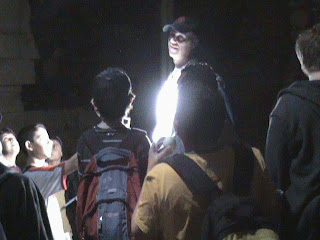
Above: Back on the Damascus Highway...
Below: The road we drove down in the school's mini-buses to get to our first castle
Yes, we did have to drive up the other side of the valley.
And yes, every single corner was terrifying.


Above: Standing in the dry moat of Salah al-Din's Citadel. The moat was mostly dug out of the bare rock - only the top-most part of the wall is actually constructed of brick and mortar.
Below: Ryan explains as the students get ready to look at their first castle. Even for a number of the Syrian students, it was the first time visiting these historic sites!


Above: Two deep valleys form natural impediments to any invader who might attempt to take Salah al-Din's Citadel.
Below: Students explore the most fortified side of Marqab, a Crusader castle overlooking the Mediterranean Sea.
Below: Ryan explains as the students get ready to look at their first castle. Even for a number of the Syrian students, it was the first time visiting these historic sites!


Above: Two deep valleys form natural impediments to any invader who might attempt to take Salah al-Din's Citadel.
Below: Students explore the most fortified side of Marqab, a Crusader castle overlooking the Mediterranean Sea.

Below: Students prepare to explore the enormous Krak de Chevalier.

 Above: This space was home to some 250 horses when Krak de Chevaliers was garrisoned by the Knights Hospitaliers.
Above: This space was home to some 250 horses when Krak de Chevaliers was garrisoned by the Knights Hospitaliers.Below: Michael demonstrates how the sunbeams coming from small openings in the ceiling were manipulated to light an entire underground room.
Far Below: Looking past the solid walls of the Krak.



